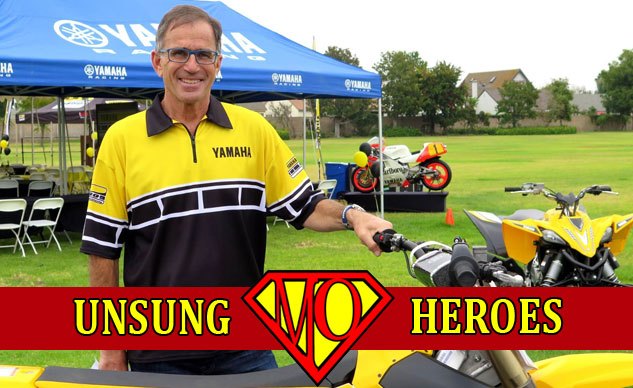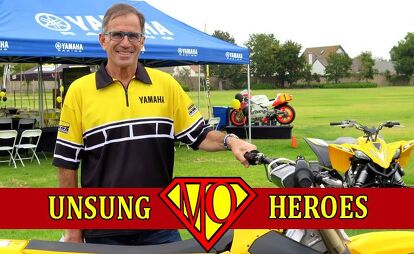Unsung Motorcycle Heroes 2: Bob Starr
It’s fair to say that those who work in the motorcycle industry do so out of their love for bikes and our two-wheeled sport/hobby. It doesn’t really matter if you’re a PR agent, a journalist or a factory representative, a person could earn more money if their job was instead in the automotive field. Meanwhile, there are thousands of moto-loving people who work tirelessly behind the scenes to promote and help enhance the world of motorcycling, routinely without any fanfare whatsoever.
That’s why we’ve decided to shine a little light on some of the people who have devoted significant portions of their lives to nurturing and advancing how we use and enjoy motorcycles in a multi-part series about those who help develop motorcycling and boost its exposure. —Kevin Duke, Editor-in-Chief
When nearly all the other factories folded their national roadracing tents and parked their 18-wheelers, one factory and its Yamaha Racing Blue trucks remained (along with the semi-factory Yoshimura Suzuki). Why did Yamaha stick with roadracing when all the other factories bailed? Cynics might say it would guarantee plenty of easy wins, but I don’t think that was it. One smiling guy you’d always see at the races was Bob Starr, who up until recently was Communications Manager for Yamaha’s Motorsports Group. (He recently became Corporate Communications Manager for the company, with a new set of responsibilities.)
MO: What was the deal, Bob, why didn’t Yamaha quit too?
Bob Starr: “That answer would really have to come from our senior management, who determined that from a budgetary standpoint, the continued investment was worth it, and from Keith [McCarty, Yamaha’s U.S. racing czar]; Of course our marketing group completely agreed with the decision that racing is extremely important to Yamaha, and we did all we could to support that effort in the hearts and minds of the fans. Keith kept up the pressure on the track and we did everything we could to support him from a marketing standpoint, in whatever form it took up to and including making videos like this one that were a lot of fun, and truly spoke to the character of Yamaha and the nature of our motorsports business.
When we looked at the downturn, after the economy tanked and the series changed hands, Yamaha thankfully decided that rather than backing off, we needed to accelerate our racing. I’m more on the marketing side, which of course derives a benefit from racing. On a personal level, I’ve been sincerely passionate about motorsports since about age 10 or 11. I just turned 60, and I feel tremendously fortunate to have turned this passion I’ve had my entire life into a career. I still love riding to work almost every day, and I’m really excited about my new role that we hope will ultimately strengthen the Yamaha brand. Yamaha music began in the late 1800s, and Yamaha Motor Company built the first YA-1 in 1955. Then there’s marine engines, boats, watercraft, ATVs, side-by-sides, snowmobiles… you can see why I’m excited!”
Yamahas On The Stage And The Road
MO: The other thing unique to Yamaha is the way it honors its past champions. In years past, there’ve been great get-togethers at places like the Monterey Bay Aquarium. Against a backdrop of glowing jellyfish in the night, with past heroes ranging from Jamie James to Wayne Rainey to Valentino Rossi all rubbing elbows and tropical cocktails, those nights were dreamlike if you’re a racing fan. More recently, Yamaha has held parties in the backyard of its Cypress, California HQ, where it’s invited and inducted a plethora of past racing champions (and the In n’ Out Burger truck). I don’t remember any of the other factories doing anything remotely like it. Who’s responsible for that, Bob?
Bob Starr: “Each of our ‘Wall of Champions’ induction events have been spearheaded by Keith, Mike Guerra and myself, with many others contributing extra effort to make them happen. When I was becoming a big roadracing fan as a teenager back east, Mike Baldwin and Rich Schlachter were absolute heroes to me. What is it now, 35 or 40 years after they began their careers? It’s great to be able to honor them and others and the contributions they’ve made to the Yamaha brand. Yamaha’s image was in fact being carved out at that time. It’s very important to keep that part of our history, and recognize these people that helped build the foundation on which Yamaha is based. Kenny Roberts is without question ‘The King,’ and everyone knows what he did. But people like Rich and Mike won championships too, and it’s important to maintain that memory. Looking back at the past helps us better plan for the future and make our company stronger.”
MO: Those of us who mostly watch racing via TV have often seen Bob peering out from the Yamaha pits at various MotoGPs and Superbike races over the years. What’s that like?
Bob Starr: “I have been to most of the U.S. rounds over the years, and I think last year was particularly exciting to be there as the the new MotoAmerica series was born. I’ve also gotten to know Valentino quite well and he is without a doubt the real deal. One of the coolest things I’ve noticed about Valentino is that if he spots a very young fan, he will make a point to give that fan an autograph or photo; he knows that that represents the future of the sport and our business. Seeing that from someone of Vale’s stature is just heartwarming to watch.”
“What all those past champions have in common is that they’re all highly interesting characters; it’s never a sacrifice to spend time with them. What they contributed to our brand is important and our cultivating those relationships is reflective of our company culture; these gentlemen put our brand where it is today. That idea runs through the whole company, beginning at the very top, in Japan, at Yamaha Communications Plaza.
“For me, a kid who got his first job on a chicken farm across the street from my childhood home back in New Hampshire when I was 11 years old – hey, it was a great job! I learned to drive a tractor, a dump truck, and bought my first motorcycle and snowmobile with the money! – it’s been a great ride. And my favorite part of doing it, after being at Yamaha 24 years, is still coming to work every day. Every day I try to do something different, mix it up – and my new opportunity will be just that! Every day it’s what’s next?”
More by John Burns




































Comments
Join the conversation
Bob is the real deal. Unfortunately, he seems to represent a dying breed amongst so many non-riding, non-enthusiast upper management types at the various corporate HQs of most motorcycle manufacturers. We need more Bobs!